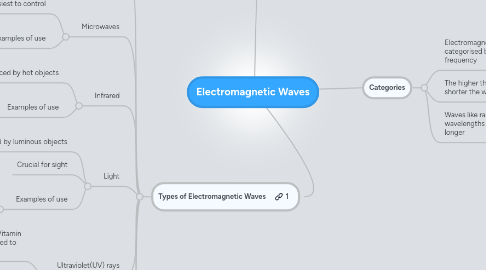
1. Types of Electromagnetic Waves
1.1. Radio waves
1.1.1. Lowest frequencies but longest wavelengths
1.1.2. Examples of use
1.1.2.1. Radio broadcasting
1.1.2.2. Telecommunication
1.1.2.3. Wireless networking
1.2. Microwaves
1.2.1. Easiest to control
1.2.2. Examples of use
1.2.2.1. Satellite communication
1.2.2.2. Cooking food
1.3. Infrared
1.3.1. Produced by hot objects
1.3.2. Examples of use
1.3.2.1. Night vision goggles
1.3.2.2. Thermal imaging
1.4. Light
1.4.1. Produced by luminous objects
1.4.2. Crucial for sight
1.4.3. Examples of use
1.4.3.1. Optical fibers
1.4.3.2. Photography
1.5. Ultraviolet(UV) rays
1.5.1. Human skin produces Vitamin D naturally when exposed to UV
1.5.2. Examples of use
1.5.2.1. Sunbeds
1.5.2.2. Fluorescence lights
1.6. X-rays
1.6.1. High frequencies
1.6.2. Able to penetrate many materials
1.6.3. Examples of use
1.6.3.1. Airport luggage scanners
1.6.3.2. Radiography
1.7. Gamma rays
1.7.1. Highest frequency and shortest wavelengths
1.7.2. Contains the most energy and hence dangerous
1.7.3. Examples of use
1.7.3.1. Sterilisation of medical equipment
1.7.3.2. Radiotherapy
2. Properties
2.1. Speed in vacuum is constant
2.2. They are transverse waves
2.3. They can be reflected and refracted
2.4. They transfer energy without a medium
3. Categories
3.1. Electromagnetic waves are categorised by wavelength and frequency
3.2. The higher the frequency, the shorter the wave length
3.2.1. Wave speed is constant
